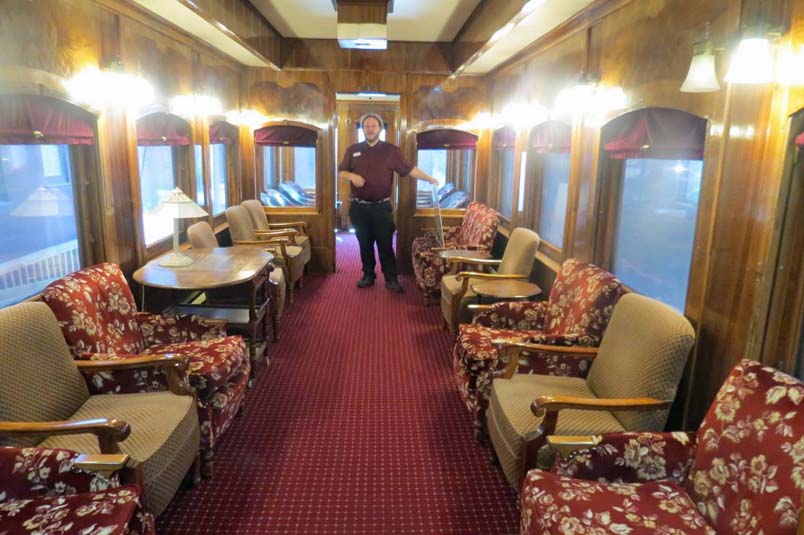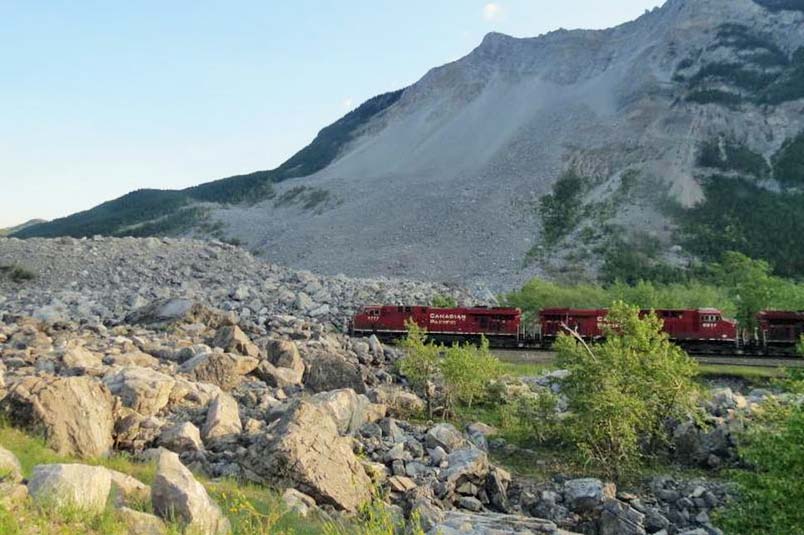
Cranbrook British Columbia - They both left an indelible mark on this earth.
One sent man to the moon 50 years ago.
The other swam around these parts cleaning the ocean 520 million years ago.
Today President John F. Kennedy, and cute little trilobites, are both big hits at the Cranbrook History Centre here in the midst of the Rocky
Mountains.
JFK and Jackie Kennedy were among the last celebrities to sleep in the rolling penthouse railway car that was the star of the Trans-Canada Limited, Canada's
most luxurious cross-country train.
 I don't
believe the Kennedy's were riding the Trans-Canada Limited prior to 1931.
I don't
believe the Kennedy's were riding the Trans-Canada Limited prior to 1931.
Now the luxury rail car and pre-historic fossils are star attractions in the large museum that tells the history of this railway town of 19,500 in southeastern
British Columbia.
The Cranbrook History Centre is home to one of North America's largest collection of retired railway passenger cars.
The centre is now a popular meeting venue for the city's various social clubs and business groups.
Most of the rolling stock arrived here in pretty rough shape, but Cranbrook has a large crew of dedicated restoration artists, carpenters, upholsterers, etc.
that are returning the rail cars to their original splendor.
Cranbrook became a railway town because it's located near the western outlet of the Crowsnest Pass, an east-west valley through the Rockies that the Canadian
Pacific Railway (CP) was looking for to push its tracks through to the Pacific Ocean without climbing over high mountains.
British Columbia's Ktunaxa Peoples had been using the pass for nearly 11,000 years as a summertime route to trade with the Blackfoot Tribes on the prairies
east of the Rockies.
Cranbrook became a significant railway junction for trains rolling in from American railways not too far south of the town, plus Alberta trains carrying wheat
to the west coast.
CP wanted financial help from the federal government because of the high cost of building a railway through a tight canyon dominated by the Crowsnest and Elk
Rivers.
Ottawa agreed to help, but in exchange for significantly reduced freight rates to carry grains across the prairies to the waiting ships at the
Lakehead.
The history centre has 28 historic railway passenger cars, 13 of which are open for public viewing, and some are occasionally rented by local groups for small
social gatherings.
There are seven cars from the 1929 Trans-Canada Limited, Canada's most luxurious cross-country train with sleeping cars, a lounge car, and elaborate dining
cars.
The Limited was very popular with wealthy American passengers because in 1929 Prohibition in the U.S. banned alcohol, but in Canada the Limited poured plenty
of booze during its six-day run from Toronto to Vancouver.
However, the New York Stock Market Crash of 1929 meant that, by 1931, the Great Depression had eliminated too many potential passengers and the Limited
stopped running for good.
The "Strathcona" was one of the executive night cars on the Limited and it was retained to carry celebrity passengers on special trips.
JFK and his wife toured parts of Canada in the car after delivering a speech to a joint session of the House of Commons and Canadian Senate in May
1961.
Queen Elizabeth II lived aboard the Strathcona while touring Canada and Winston Churchill travelled around Canada in the Strathcona after meeting with
President Franklin D. Roosevelt in Quebec City in 1943 to plan a D-Day invasion of Europe.
CP built many beautiful hotels along its rails in Canada that are still among the country's finest.
However, its Winnipeg hotel, the Royal Alexandra, no longer exists.
It was built in 1906 and reigned supreme in Winnipeg for 60 years, but was closed in 1967 and demolished in 1971.
One of the finest features of the Royal Alex, as it was called, was it's fine dining room.
It was saved from the demolition and carefully preserved and stored hoping to be born again in Winnipeg, but it never happened.
After 25 years in storage, the dining room was sent by train to Cranbrook and reassembled to its original glory in the Cranbrook History Centre, where it
often hosts the biggest parties in town.

The Frank Slide
Only a few years after CP started running its trains trough the Crowsnest Pass, the line was blocked by one of Canada's most unusual disasters.
The face fell off Turtle Mountain and crushed part of the town of Frank, Alberta, with 121 million tons of limestone.
More than 100,000 visitors a year now visit an interpretive centre in Crowsnest Pass that tells the story of the Frank Slide.
About 600 people lived in the valley town below Turtle Mountain at the time.
It was created two years earlier to service a large coal mine that was cut into the mountain.
Now 90 of its residents are buried under the huge boulders and rubble that came crashing down off the mountain at 04:10 in the morning on
29 Apr 1903.
The slide dammed up the Crowsnest River and buried the CP line.
The first priority of rescuers was to dynamite a new path for the river so it wouldn't flood out the surviving part of town.
CP brought in large crews from nearby Cranbrook to open a gap in the slide and trains were running again within three weeks.
Later, a route for Provincial Highway 3 was punched through the rubble to reconnect Leighbridge and Cranbrook.
Today, the disaster site looks much as it did when the sun rose on 29 Apr 1903, although the dust has settled.
Pat Brennan.
 Article
abridged - paleontology data removed.
Article
abridged - paleontology data removed.
provisions in Section 29 of the Canadian
Copyright Modernization Act.

